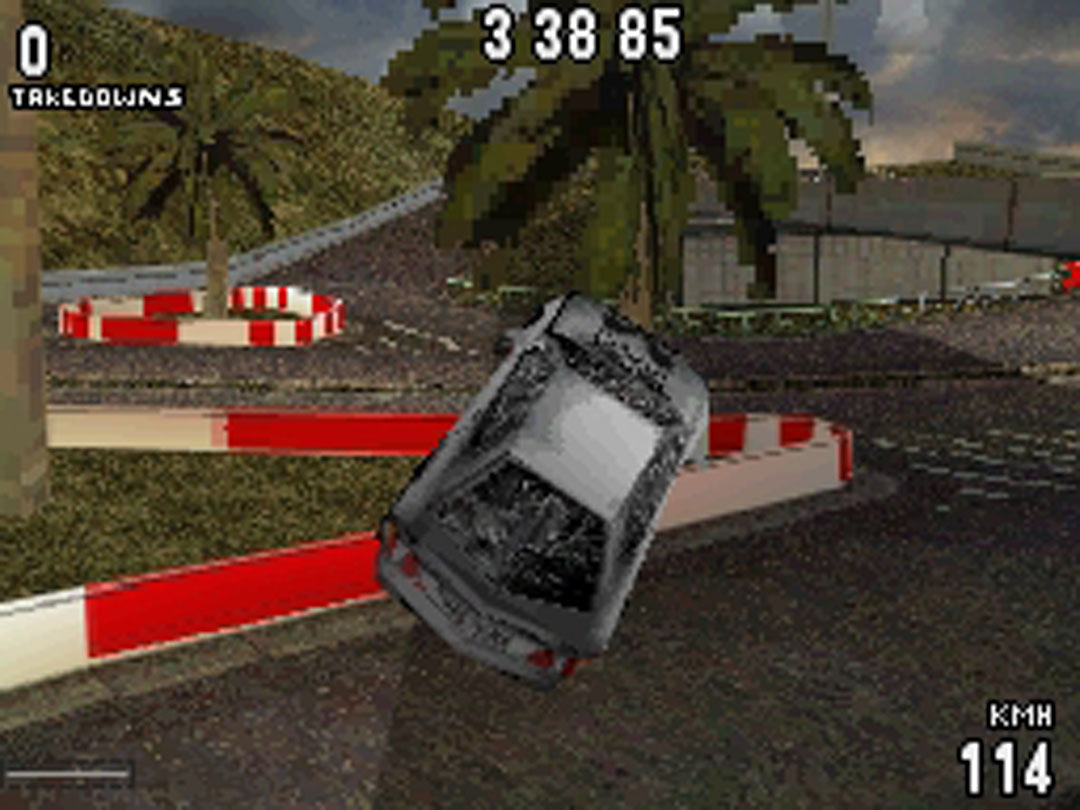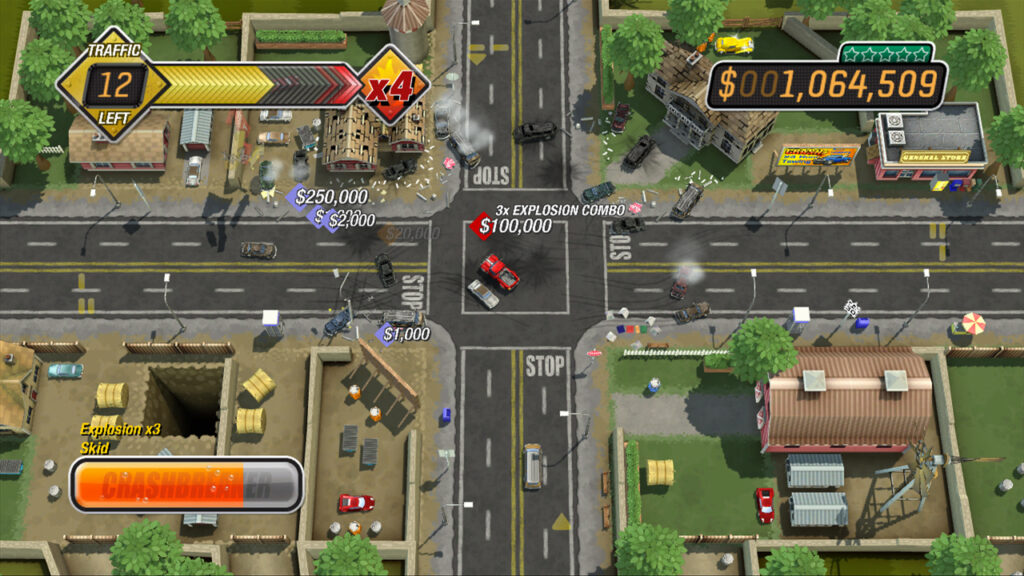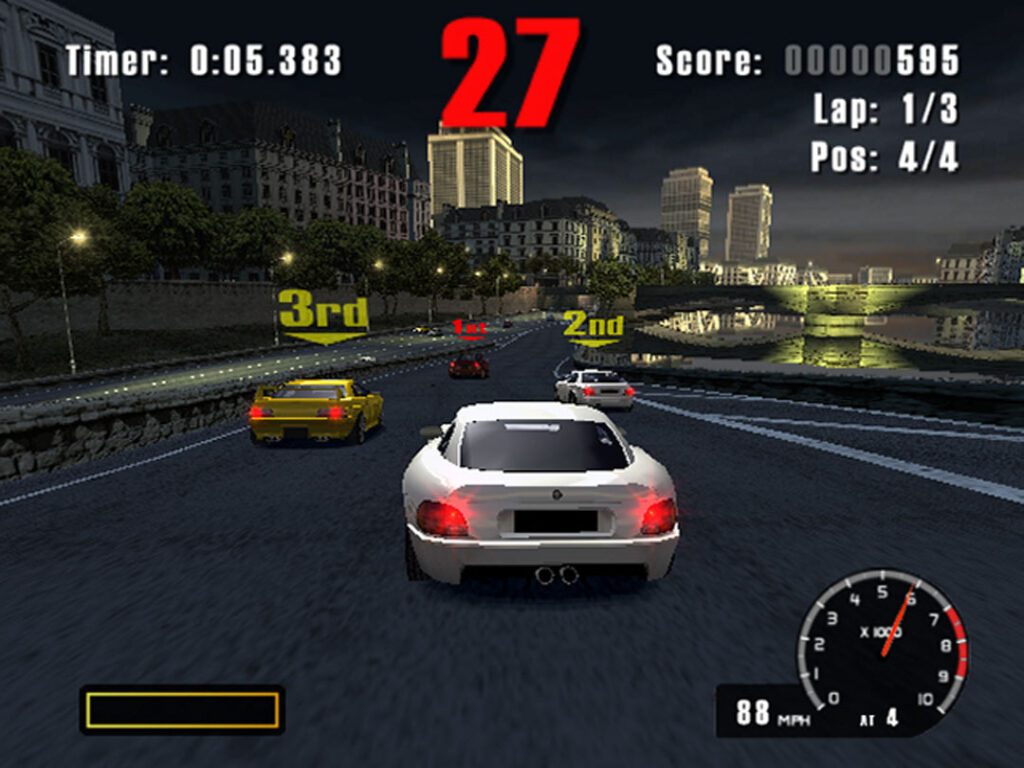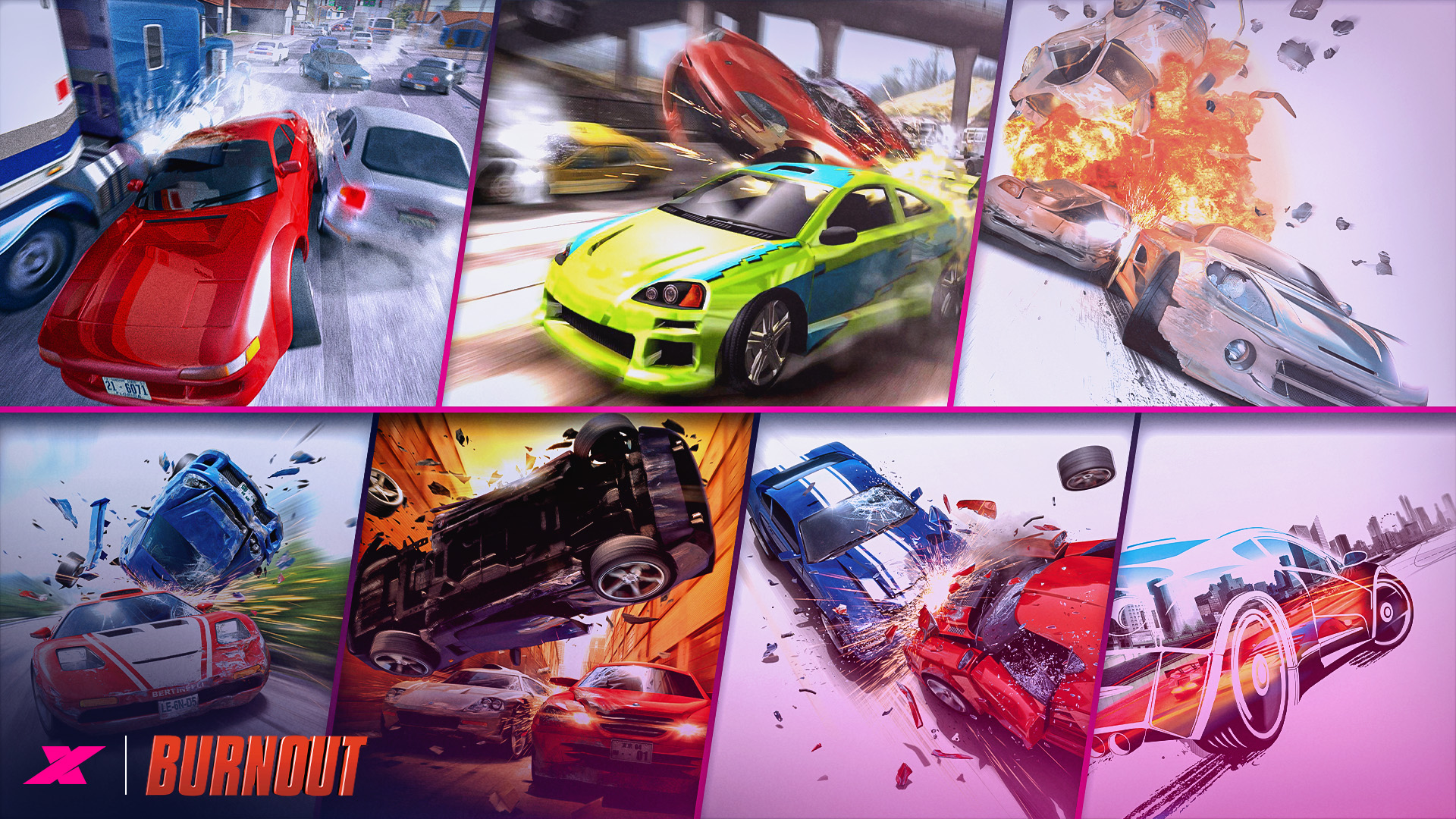Burnout is beloved for its high-octane arcade racing, blistering speed and bone-crunching crashes. It’s baffling, then, that the franchise has been dormant for over 15 years, with the last mainline entry releasing in 2008.
With the release of Wreckreation from the original visionaries, we’re revisiting every Burnout game and ranking them from worst to best.
Honourable mentions
Although there hasn’t been a new entry since 2011, several spiritual successors have emerged since then. While they don’t live up to Burnout’s legacy, they are worth seeking out for aficionados.
With no signs of EA reviving the franchise, original creators Fiona Sperry and Alex Ward left Criterion Games to form Three Fields Entertainment in 2014. Since then, the small team has developed several driving games evoking Burnout’s spirit, with each new entry becoming more audacious.
Its first game, Dangerous Golf in 2016, was a novel spin on Burnout’s Crash mode, with you destroying indoor environments with a flying golf ball. 2017’s Danger Zone, on the other hand, was a more traditional take but restricted to bland indoor test centres, while its 2018 sequel, Danger Zone 2, brought back outdoor city crash junctions.

It wasn’t until 2019 that Three Fields released its first racing game. A spiritual successor to Burnout 3, Dangerous Driving saw the return of series staples like takedowns, point-to-point racing and Road Rage, but lacked the polish of the game that inspired it.
Another six years would pass until the studio’s next Burnout homage. Originally intended as a direct sequel to Dangerous Driving, Wreckreation is the studio’s most ambitious title to date, blending chaotic arcade racing with a customisable open world. Think Burnout Paradise meets Trackmania.
While it lacks refinement and the environment feels empty, Wreckreation is the closest to a new Burnout game for now.
9. Burnout Legends (DS)

Whereas Criterion handled the PSP port of Burnout Legends, the Nintendo DS port was developed by Visual Impact. And it was a disaster.
Hardware limitations meant Burnout translated poorly to Nintendo’s handheld, with sparse traffic, terrible graphics and cars clipping through objects during crashes. That makes Burnout Legends on DS easily the worst game in the series. Its inferior quality makes it look and play like a separate game to its PSP sibling. This, coupled with a different developer handling it, makes it deserve its own entry in our Burnout rankings list.
8. Burnout Crash!

Crash mode was such a hit that it was adapted into a digital-only spin-off game in 2011, with the aptly-named Burnout Crash! Played from a top-down perspective, players earned points by damaging traffic cars and destroying the environment, competing for high scores in an online leaderboard.
However, the cartoony visuals were a departure, removing the destruction’s spectacle. It looked and played like a mobile game on PS3 and Xbox 360, making it a good fit for mobiles when it was ported to iOS a year later. But as a successor to Burnout Paradise, the console version ended the series on a whimper rather than a bang.
7. Burnout

Heavily inspired by Hollywood car chases and Konami’s Thrill Drive arcade cabinet games, Burnout’s simple yet addictive risk vs. reward gameplay set the template for the series.
As you raced on crowded city streets set in the US and Europe, near misses with traffic would fill a boost bar, rewarding reckless driving. Once it was full, activating a speed boost tested your reaction times as you weaved through heavy traffic. Chaining boosts together would trigger a ‘Burnout.’
When you inevitably slammed head-on into an oncoming truck, the crashes were brutal and cinematic, replaying the mayhem from multiple angles before resetting you back onto the road.
Arriving in 2001 at a time when bombastic arcade racers were fading in favour of realistic games like Gran Turismo, Burnout was a strong debut, though the crashes seem tame compared to later entries. Tight time limits, heavy traffic and rubber band AI make it the most difficult, and sometimes frustrating, game in the franchise.
6. Burnout Legends (PSP)

With the series gaining momentum, Burnout made its handheld console debut with the release of Burnout Legends on PSP and Nintendo DS. Released in 2005, it was essentially a best of compilation, combining Burnout 3’s signature takedowns and Road Rage with Burnout 2’s Pursuit mode, alongside cars and circuits from the first three games.
The result was respectable. Remarkably, its polished visuals and gameplay were almost on par with the console entries, allowing players to enjoy Burnout on the go with few compromises – at least on PSP. Unfortunately, the same can’t be said for the dismal DS port, which we ranked at the bottom at number nine.
5. Burnout Dominator

Burnout Dominator is the black sheep of the franchise. Released on PS2 and PSP in 2007, it was a stopgap to occupy players until Burnout Paradise arrived on PS3 and Xbox 360 a year later. But by this point, many players had moved on to the next-generation platforms.
Notably, it’s the only game in the series not developed by Criterion outside of platform-specific ports, instead helmed by EA UK. A back-to-basics approach led to the return of boost chaining and a new Maniac mode rewarding points for dangerous driving, but the revered Crash mode was sadly absent.
While Burnout Dominator is a serviceable entry in the series, it’s also one of the most forgettable.
4. Burnout Revenge

Arriving just one year after Burnout 3: Takedown, Burnout Revenge doubled down on the series’ new combat-focused direction, with more inventive ways to take out rivals. A new ‘Revenge Takedown’ mechanic highlighted whenever you destroyed a rival who previously took you out, or you could land on opponents in ‘Vertical Takedowns.’
Compared to previous games, the grittier graphics gave the game a darker look, and the tracks were more intricately designed, incorporating shortcuts, alternate routes and obstacles to avoid.
While the enhanced Xbox 360 version, which marked the series’ HD debut and is backwards compatible on Xbox Series X|S, is fondly remembered, Traffic Checking, which formed the basis for the new Traffic Attack mode, proved divisive.
Ramming civilian vehicles driving in the same direction out of the way was cathartic, especially when using the traffic like a weapon to take out rivals, but it diluted the risk-vs-reward element that its predecessor had perfected.
3. Burnout 2: Point of Impact

Burnout 2: Point of Impact was a perfect sequel, in that it improved on the original game in every way.
The racing was faster and more intense, and with more vehicles, including the cover car inspired by the Mitsubishi Eclipse from The Fast and the Furious, which would return in every game, and new game modes, the sequel was a more substantial package. Thanks to improved damage modelling, crashes were more spectacular, too, with vehicle parts now flying off.
Another highlight was Pursuit Mode. Predating Criterion’s Need for Speed Hot Pursuit, this Chase HQ-style mode saw you pursuing speedsters in a police car and ramming them repeatedly until they wrecked when their damage meter ran out.
However, Burnout 2 is best known for introducing Crash Mode, which saw players drive into busy junctions and cause as much chaos as possible, with high scores determined by the amount of insurance damage incurred. This fan-favourite mode has become a staple of the franchise ever since it debuted in Burnout 2.
2. Burnout Paradise

By moving away from closed point-to-point circuits in favour of a sprawling open world, Burnout Paradise is the most polarising entry. Some fans love it, but others resent having to work out the best route to the finish line during races. Its new ‘Showtime’ mode was also a poor substitute for Crash mode.
While not everyone loved the change in direction, the map design was undeniably impeccable, with a variety of memorable locations, shortcuts and events. With barely any menus to navigate, starting an event was as easy as stopping at traffic lights and holding the accelerator and brake. Finding every smashable billboard and gate hidden around the map encouraged exploration.
Burnout Paradise was ahead of its time. Launching in 2008, just as open-world racers were gaining traction after the launch of Test Drive Unlimited, and predating Forza Horizon, its seamless multiplayer was pioneering. Rather than waiting in lobbies, players could join online sessions instantaneously while driving around with no loading screens – an impressive feat for the time.
While you could enter competitive races around the city with other players, the cooperative ‘Freeburn’ challenges were the real highlights. These mini party game-style challenges tasked teams to drift certain distances, perform jumps or gather at a location. Beyond the events, meeting with friends and casually cruising around Paradise City was fun in its own right.
Since the 2018 remaster is backwards compatible with current-generation hardware, you can revisit Paradise City on PS5 and Xbox Series X|S. Even though the original is over 15 years old, the open-world racer still holds up remarkably well. Burnout Paradise never got the sequel it deserved, but its spiritual successor, Wreckreation, developed by ex-Criterion staff, has plenty of fan-pleasing references to the influential city driving game.
1. Burnout 3: Takedown

Burnout 3: Takedown is the pinnacle of the franchise.
Its titular Takedown mechanic transformed the series going forward. Encouraging aggressive driving, races turned into frenetic battles, letting you slam opponents into oncoming traffic or side walls to temporarily take them out of the race, resulting in Hollywood-style wrecks. Crashes no longer hindered you, either, with the new Aftertouch feature allowing you to steer your wreck into the path of oncoming rivals.
Takedowns were also the focus of the now-popular Road Rage mode, which challenged players to take out as many opponents as possible within a time limit. Crash Mode was even more chaotic, too, thanks to the debut of ‘Crashbreakers’ that triggered massive explosions. This destructive power-up not only blew up nearby vehicles, but it also let you strategically fly your car through the air to collect bonus cash pickups.
As the first entry published by EA, a bigger budget meant the visuals, vehicle damage and audio were taken to the next level. The leap in production quality from Burnout 2 to Burnout 3 can’t be overstated.
Meanwhile, its officially licensed soundtrack, a first for the series, is a time capsule for mid-2000s pop punk and indie rock, featuring artists like Franz Ferdinand and Funeral for a Friend.
Over 20 years on, Burnout 3: Takedown still ranks as one of the best arcade racers ever made, leaving fans clamouring for a remaster or remake.
Do you agree with our Burnout game rankings? Let us know in the comments below.





Chat with the Community
Sign Up To CommentIt's completely Free